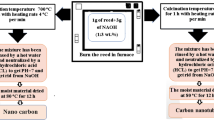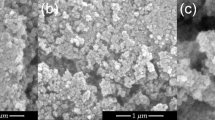Abstract
Steady-state fluorescence and UV–Vis techniques were used to study the film formation behavior of composites consisting of pyrene (P)-labeled polystyrene (PS) latex and graphene oxide (GO) in terms of PS latex/GO volume fraction. PS/GO composite films were prepared on glass substrates with different volume fractions of PS and GO using the drop casting method at room temperature. The film formation behavior of these composites was studied by annealing them at a temperature range of 100–300 °C and monitoring the scattered light intensity (Isc), fluorescence intensity (IP) from P and transmitted light intensity (Itr) through the films after each annealing step. The optical results indicate that PS/GO composites showed complete film formation independent of GO volume fraction. The morphological changes in the films were also found to be in consistent with these results.







Similar content being viewed by others
References
Mohammadi N, Klein A, Sperling LH (1993) Polymer chain rupture and the fracture behavior of glassy polystyrene. Macromolecules 26:1019
Sambasivan M, Sperling LH, Klein A (1995) Energy-consuming micromechanisms in the fracture of glassy polymers. 2. Effect of molecular weight on the fracture of polystyrene. Macromolecules 28:152
Pekcan O, Arda E, Kesenci K, Piskin E (1998) Photon transmission technique for studying film formation from polystyrene latexes prepared by dispersion polymerization using various steric stabilizers. J Appl Polym Sci 68:1257
Sambasivan M, Klein A, Sperling LH (1995) The molecular basis of fracture in polystyrene films: role of molecular weight. J Appl Polym, Sci
Wang Y, Winnik MA (1993) Polymer diffusion across interfaces in latex films. J Phys Chem 97:2507
Canpolat M, Pekcan O (1995) Photon diffusion study in films formed from high-T latex particle. Polymer 36:4433
Canpolat M, Pekcan O (1995) Healing and interdiffusion processes at particle–particle junction during film formation from high-T latex particles. Polymer 36:2025
Pekcan O, Canpolat M (1996) The effect of solid content on latex coalescence and film formation: steady-state energy transfer study with fluorescence labeled polymers. J Appl Polym Sci 59:1699
Winnik MA (1997) Latex film formation. Curr Opin Colloid Interface Sci 2(2):192
Toussaint A, Wilde MD (1997) A comprehensive model of sintering and coalescence of unpigmented latexes. Prog Org Coat 30:113
Croll SG (1986) Drying of latex paint. J Coat Technol 58(734):41
Provder T, Winnik MA, Urban MW (1996) Film formation in waterborne Coatings. In: ACS symposium American chemical society series 648, p 332
Sperry PR, Synder BS, O’Dowd ML, Lesko PM (1994) Role of water in particle deformation and compaction in latex film formation. Langmuir 10(8):2619
Mackenzie JK, Shuttleworth R (1949) A phenomenological theory of sintering. Proc Phys Soc B 62(12):838
Mazur S (1995) Coalescence of polymer particles. In: Rosenweig N (ed) Polymer powder processing. Wiley, Chister
Pekcan O, Arda E (1999) Void closure and interdiffusion in latex film formation by photon transmission and fluorescence methods. Colloids Surf A Physicochem Eng Asp 153:537
Kanig G, Neff H (1975) Ein neues Kontrastierverfahren für die elektronenmikroskopische Untersuchung vonsäure-und estergruppenhaltigen Polymersystemen. Colloid Polym Sci 253:29–31
Wang Y, Kats A, Juhue D, Winnik MA, Shivers RR, Dinsdale CJ (1992) Freeze-fracture studies of latex films formed in the absence and presence of surfactant. Langmuir 8:1435
Roulstone BJ, Wilkinson MC, Hearn J, Wilson AJ (1991) Studies on polymer latex films: I. A study of latex film morphology. Polym Int 24:87
Kim KD, Sperling LH, Klein A (1993) Characterization of film formation from direct miniemulsified polystyrene latex particles via SANS. Macromolecules 26:4624
Pekcan Ö, Winnik MA, Croucher MD (1990) Fluorescence studies of coalescence and film formation in poly(methyl methacrylate) nonaqueous dispersion particles. Macromolecules 23:2673
Wang Y, Zhao CL, Winnik MA (1991) Molecular diffusion and latex film formation: an analysis of direct nonradiative energy transfer experiments. J Chem Phys 95:2143
Wang Y, Winnik MA (1993) Energy-transfer study of polymer diffusion in melt-pressed films of poly(methyl methacrylate). Macromolecules 26:1347
Pekcan Ö, Canpolat M (1996) Direct fluorescence technique to study evolution in transparency and crossing density at polymer–polymer interface during film formation from high-T latex particles. J Appl Polym Sci 59:277
Pekcan Ö, Canpolat M, Göçmen A (1993) Variation in optical density during latex film formation: interdiffusion of fluorescence labelled polymers. Polymer 34:3319
Canpolat M, Pekcan Ö (1996) Healing and photon diffusion during sintering of high-T latex particles. J Polym Sci Polym Phys Ed 34:691
Arda E, Bulmus V, Piskin E, Pekcan Ö (1999) Molecular weight effect on latex film formation from polystyrene particles: a photon transmission study. J Colloid Interface Sci 213:160
Pekcan Ö, Arda E (1999) Void closure and interdiffusion in latex film formation by photon transmission and fluorescence methods. Colloids Surf A 153:537
Salavagione HJ, Martínez G, Ellis G Garphene-based polymer nanocomposites. Institute of Polymer Science and Technology, Spanish National Research Council (CSIC) Spain
Potts JR, Dreyer DR, Bielawski CW, Ruoff RS (2011) Graphene-based polymer nanocomposites. Polymer 52:5–25. https://doi.org/10.1016/j.polymer.2010.11.042
Stankovich S, Dikin DA, Dommett GHB, Kohlhaas KM, Zimney EJ, Stach EA, Piner RD, Nguyen ST, Ruoff RS (2006) Graphene-based composite materials. Nature 442:282–286. https://doi.org/10.1038/nature04969
Stankovich S, Dikin DA, Dommett GHB, Kohlhaas KM, Zimney EJ, Stach EA (2006) Graphene-based composite materials. Nature 442:282–286
Ansari S, Giannelis EP (2009) Functionalized graphene sheet—poly (vinylidene fluoride) conductive nanocomposites. J Polym Sci Part B Polym Phys 47:888–897
Ramanathan T, Abdala AA, Stankovich S, Dikin DA, Alonso MH, Piner RD (2008) Functionalized graphene sheets for polymer nanocomposites. Nat Nanotechnol 3:327–331
Lee YR, Raghu AV, Jeong HM, Kim BK (2009) Properties of waterborne polyurethane/functionalized graphene sheet nanocomposites prepared by an in situ method. Macromol Chem Phys 210:1247–1254
Xu Y, Wang Y, Jiajie L, Huang Y, Ma Y, Wan X (2009) A hybrid material of graphene and poly (3, 4-ethyldioxythiophene) with high conductivity, flexibility, and transparency. Nano Res 2:343–348
Quan H, Zhang B, Zhao Q, Yuen RKK, Li RKY (2009) Facile preparation and thermal degradation studies of graphite nanoplatelets (GNPs) filled thermoplastic polyurethane (TPU) nanocomposites. Compos Part A 40:1506–1513
Eda G, Chhowalla M (2009) Graphene-based composite thin films for electronics. Nano Lett 9:814–818
Liang J, Xu Y, Huang Y, Zhang L, Wang Y, Ma Y et al (2009) Infrared-triggered actuators from graphene-based nanocomposites. J Phys Chem 113:9921–9927
Kim H, Macosko CW (2009) Processing-property relationships of polycarbonate/graphene composites. Polymer 50:3797–3809
Dikin AK, Stankovich S, Zimney EJ, Piner RD, Dommett GHB, Evmenenko G (2007) Preparation and characterization of graphene oxide paper. Nature 448:457–460
Singh K, Ohlan A, Dhawan SK Polymer-graphene nanocomposites: preparation characterization, properties, and applications. Additional information is available at the end of the chapter http://dx.doi.org/10.5772/50408
Ugur S, Elaissari A, Pekcan O (2003) Void closure and interdiffusion processes during latex film formation from surfactant-free polystyrene particles: a fluorescence study. J Colloid Interface Sci 263(2):674–683
Ugur S, Elaissari A, Pekcan O (2004) Film formation from surfactant-free, slightly crosslinked, fluorescein-labeled polystyrene particles. J Coat Technol Res 1(4):305–313
Pan S, Aksay IA (2011) Factors controlling the size of graphene oxide sheets produced via the graphite oxide route. ACS Nano 5:4073–4083. https://doi.org/10.1021/nn200666r
Stankovich S, Dikin DA, Dommett GHB, Kohlhaas KM, Zimney EJ, Stach EA, Piner RD, Nguyen ST, Ruoff RS (2006) Graphene-based composite materials. Nature 442:282–286. https://doi.org/10.1038/nature04969
Meeten GH (1989) Optical properties of polymers, vol 353. Elsevier, London
Liu JS, Feng JF, Winnik MA (1994) Study of polymer diffusion across the interface in latex films through direct energy transfer experiments. J Chem Phys 101:9096–9103
Keddie JL, Meredith P, Jones RAL, Donald AM, Provder T, Winnik MA, Urban MW (eds) ACS Symposium Series 648, pp 332–348. American Chemical Society (1996)
McKenna GB (1989) Polymer properties. In: Booth C, Price C (eds) Comprehensive polymer science, vol 2. Pergamon Press, Oxford
Vogel H (1925) Phys Z 22:645
Fulcher GS (1925) Analysis of recent measurements of the viscosity of glasses. J Am Ceram Soc 8:339
Frenkel J (1945) Viscous flow of crystalline bodies under the action of surface tension. J Phys USSR 9:385–391
Prager S, Tirrell M (1981) The healing process at polymer–polymer interfaces. J Chem Phys 75:5194
Wool RP, Yuan BL, McGarel OJ (1989) Welding of polymer interfaces. J Polym Eng Sci 29:1340
de Gennes PG (1982) Kinetics of diffusion‐controlled processes in dense polymer systems. II. Effects of entanglements. J Chem Phys 76:3322
Pekcan Ö, Arda E (1999) Void closure and interdiffusion in latex film formation by photon transmission and fluorescence methods. Colloids Surf A 153:537
Acknowledgements
Dr. Sunay thanks the Laboratories in Physics Department of ITU, where she has done the experimental work to prepare this article. We would like to thank Dr. Abdelhamid Elaissari for supplying us with latex materials.
Author information
Authors and Affiliations
Corresponding author
Additional information
Publisher's Note
Springer Nature remains neutral with regard to jurisdictional claims in published maps and institutional affiliations.
Rights and permissions
About this article
Cite this article
Sunay, M.S., Uğur, Ş. & Pekcan, Ö. Fluorescence and photon transmission techniques for studying film formation from PS/GO nanocomposites. Polym. Bull. 77, 3061–3077 (2020). https://doi.org/10.1007/s00289-019-02897-7
Received:
Revised:
Accepted:
Published:
Issue Date:
DOI: https://doi.org/10.1007/s00289-019-02897-7




